I’m moving again this week, back into Manhattan, and things have been busy on top of that and probably will remain to be until after Aug. So it may be slow going on the ol’blog here. I do have some new NYC Journal work, but my scanner broke, so that’ll have to wait.
For now I’ll post Beckett’s last poem, “What is the Word.”
WHAT IS THE WORD
Samuel Beckett
for Joe Chaikinfolly
folly for to –
for to –
what is the word –
folly from this –
all this –
folly from all this –
given –
folly given all this –
seeing –
folly seeing all this –
this –
what is the word –
this this –
this this here –
all this this here –
folly given all this –
seeing –
folly seeing all this this here –
for to –
what is the word –
see –
glimpse –
seem to glimpse –
need to seem to glimpse –
folly for to need to seem to glimpse –
what –
what is the word –
and where –
folly for to need to seem to glimpse what where –
where –
what is the word –
there –
over there –
away over there –
afar –
afar away over there –
afaint –
afaint afar away over there what –
what –
what is the word –
seeing all this –
all this this –
all this this here –
folly for to see what –
glimpse –
seem to glimpse –
need to seem to glimpse –
afaint afar away over there what –
folly for to need to seem to glimpse afaint afar away over there what –
what –
what is the word –what is the word
This poem was found on Avedon’s bathroom mirror after he died – now, this is not meant frivolously, but anytime a poem is taped to a mirror, it inherently becomes something touching and something more b/c it’s glimpsing two people, an author and reader, in a manner becoming a mirror itself. And this poem, well, this poem is moving in that it was Beckett’s last, and after a lifetime of writing, of trying to say what he needed to say through language, the poem shows him at the edge of language’s knowledge, peering into the unutterable, feeling it but unable to speak it, and still searching for more words, for that right word, and this search amounts to “folly.” It’s a beautiful poem of struggle and humility and art, and I think I can see what Avedon saw in it. (On top of Avedon, I suspect Wittgenstein would have taped this poem up someplace too.)
(More on Avedon and Beckett here.)
Man Ray was ahead of his time, indeed, way way ahead of his time. He’s the kind of photographer that will always inspire and scare other photographers – forever – b/c he did things first and best that will continue to come and go from fashion. What does this mean? Well, it means after I use solarization in my next story, later whilst I’m loafing around Cafe Gitane pontificating on the trends I’m setting, I’ll have eating away in my conscious the fact that Man Ray already hit that nail on the head nearly 100 years ago. (This goes even for artsy lesbian pornography, which I’m not shooting yet, but which Man Ray already did.) I really have noticed solarization is trying right now in fashion photography. It’s hard to gather enthusiasm about it in it’s modern Photoshop-filter form, at least compared to Man Ray’s pieces…just look at this pic and how timeless it is:
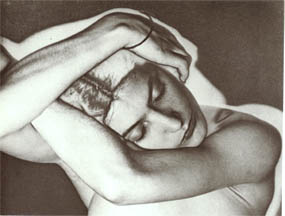
photo: woman with folden arms, © Many Ray (date unknown)
vs. this recent pic by Ruven Afanador (with Art Dept), who’s other work I’m fond of,
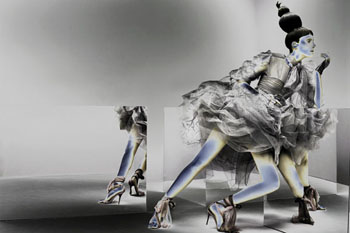
photo: © Ruven Afanador (publication and date unknown, found here)
Or if you’ve seen much of Inez and Vinoodh’s portraits (at Art and Commerce), you’ll see an – intended or not – development upon Man Ray’s blurred faces.
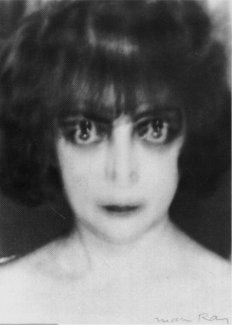
photo: La Marquise Casati, 1922, © Many Ray
vs. this portrait of Philip Seymour Hoffman for the New York Times 2006 Great Performers Series (slide show here).
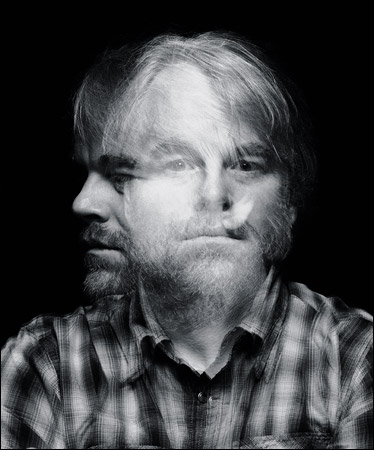
photo: Philip Seymour Hoffman, © Inez van Lamsweerde and Vinoodh Matadin for The New York Times
All fantastic work.
I’ve held Hiroshi Sugimoto’s work in high regards since I first encountered it. His pictures of movie theater screens are strong, but my favorite are his sea ‘scapes. I can imagine an argument that they’re not original, but I think they are elegant and beautiful. Now, unfortunately, I’ve only ever seen Sugimoto’s work in books, but one can only imagine his prints are exquisite. (If you’re interested, there are also some podcasts with Sugimoto here.)

photo: Boden Sea, Uttwil, 1993. ©Hiroshi Sugimoto

photo: Bass Strait, Table Cape, 1997. ©Hiroshi Sugimoto
To continue the theme of the last post on Koudelka’s fierce prints I wanted to put Mario Giacomelli’s work on here too. His photographs are something else being full of life from frame edge to frame edge, and again, as I just mentioned, the style of his printing really contributes to his overall vision. In his book there is much of his latter work that I was unable to find online, but it is worth digging up -Â it’s like Meatyard and Ballen put in a bowl and stirred with much spice and brooding.
To put it simple, it’s just really exceptionally creative work that I’d think would make most any photographer jealous.
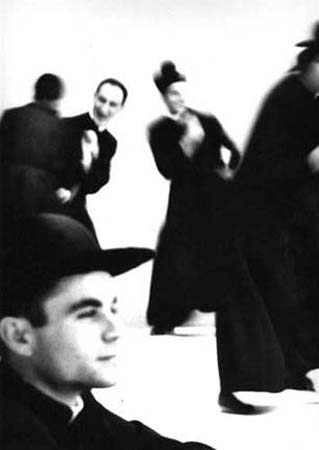
photo: title and date unknown, ©Mario Giacomelli
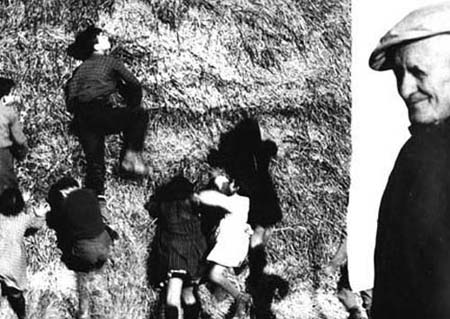
photo: title and date unknown, ©Mario Giacomelli
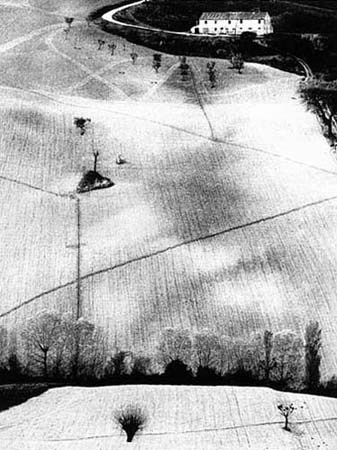
photo: title and date unknown, ©Mario Giacomelli

photo: title and date unknown, ©Mario Giacomelli
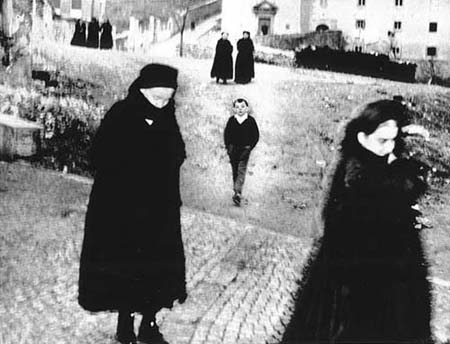
photo: title and date unknown, ©Mario Giacomelli
“The maximum, that is what has always interested me.” – Joseph Koudelka
You’d think this quote is a tad hyperbolic, but I think it’s not so full of trope and more honest than one would presume coming from Koudelka. I was looking at two of his books today. Initially, I was struck by really nice prints (done primarily by Vojin Mitrovic at Picto labs in Paris), but then I just kept getting sucked deeper and deeper into Koudelka’s work. Maybe I was prone to profundity this afternoon, but I saw a great capacity for intelligence and vision that functions by transcending the everyday in his images.
Many of his picture’s – the less overtly photojournalistic ones mostly – rhythm and composition, brought to mind the sensibility Eggleston purported
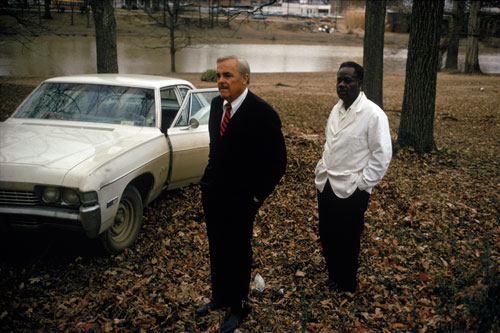
photo: Adyn and Jasper, by William Eggleston. © 2005 Eggleston Artist Trust
Though the comparison of Eggleston and Koudelka doesn’t go much further than that except for their dedication to the more panoramic of formats, 2:1 for Eggleston, 3:1 for Koudelka later in his career. I say the comparison falls off b/c I think Eggleston’s images tend to point you in a direction, suggesting what you’re to think or just being more implicit with their sense of irony. Maybe this is a function of the color, I don’t know? Koudelka, on the other hand, you sink into his images all the same, but they don’t guide you at all, more like they spin you around and then let you figure out for yourself where you are and what’s going on. What I’m referring to comes from a subtle sense of abstraction that is present in a lot of his work. His images of the wrist-hand-watch in the center of totally unrelated scene is a perfect example of how his work is good… Unfortunately, more of the work I’m referring to is his later panoramic images that are harder to come by, but if you can find a book of his you’ll see what I’m talking about.

photo: Czeckoslovikia 1968. © Joseph Koudelka

photo: Ireland 1972. © Joseph Koudelka
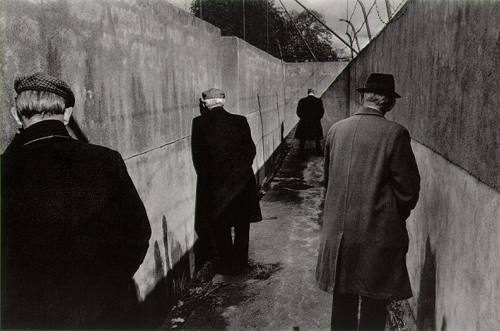
photo: Ireland 1976. © Joseph Koudelka

photo: Spain 1971. © Joseph Koudelka
Update: I guess it turns out, after talking with someone in regards to this post, that I just missed Koudelka speaking here in NYC early this April at the Aperture Gallery in Chelsea, moderated by photo critic Vicki Goldberg. I’m happy to say thanks to the internet I did find this mp3 recording of the talk courtesy of Max Pasion, which I’ll also stream here.
[audio:koudelka_talk.mp3]
Joseph Koudelka speaking at Aperture Gallery in New York City. April, 2007. Moderated by Vick Goldberg.
Update 2: some of those panoramas I was talking about from Koudelka’s book The Black Triangle. Hopefully it’ll make my Eggleston comment a bit more sane:

photo: From the book, The Black Triangle. © Joseph Koudelka

photo: From the book, The Black Triangle. © Joseph Koudelka